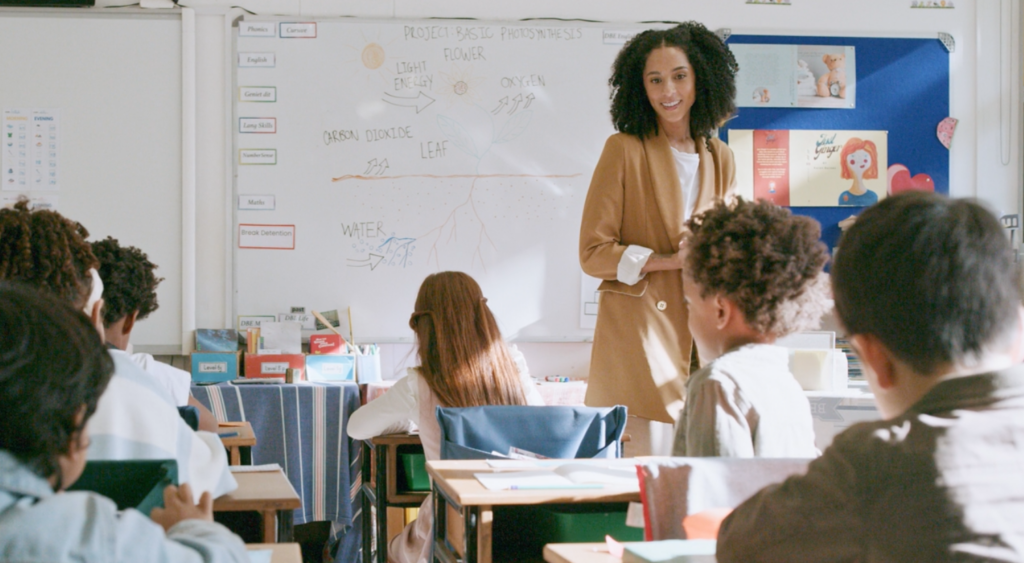What does an occupational therapist do in schools?

An occupational therapist in schools helps students improve essential skills to enhance their independence and success at school. From handwriting to sensory processing, occupational therapists create personalized plans to assist students’ individual needs as outlined by an IEP or 504 Plan.
Top duties of an occupational therapist in schools.
- Helps students with motor skills.
- Matches school tasks with students’ abilities.
- Tailors a students’ classroom environments to make learning more accessible.
- Assists students with organization skills to complete work on time.
- Collaborates with parents and teachers.
Which students do occupational therapists support?
School-based occupational therapists support many types of students, especially those with disabilities, injuries, or conditions that impact their everyday activities. Here are some challenges an occupational therapist can help students address:
- Delayed milestones or motor difficulties
- Cognitive impairments
- Speech or language difficulties
- Physical limitations
- Visual or hearing difficulties
- Behavioral or emotional conditions
Occupational therapists work with students of all ages. Much of their work in lower grades involves helping children gain essential self-regulation skills and reach key developmental milestones, such as enhancing fine motor skills necessary for school-based tasks.
A key focus for children is self-regulation. An occupational therapist might provide strategies to help students manage their reactions, feel more in control, and foster creative problem-solving skills.
The ability to control and manage your thoughts, emotions, and behaviors in different situations is crucial for success in the classroom. Self-regulation helps students follow instructions, stay focused on tasks, and collaborate with peers, leading to a positive learning experience.
Occupational therapists working in high schools may focus on similar challenges related to performing daily tasks and school activities. However, there is more of an emphasis on preparing for adulthood. For example, a high school occupational therapist might assist students with typing, life skills development, vocational skills, or budgeting.
One-on-one student support.
Offering individual support is key to what an occupational therapist does in schools. When a student shows signs of difficulties communicating, learning, or performing daily activities, occupational therapists step in to evaluate their situation. They’ll work one-on-one with students to understand their needs and help them get better access to their education.
Occupational therapists also design personalized treatment plans. They collaborate with teachers, parents, and other school-based professionals to tailor the best approach for student success. Whether this requires special devices or learning materials, a school occupational therapist strives to help students gain vital skills to better interact with the world around them.
School occupational therapists track student growth, providing progress reports over time. They also offer recommendations and modify a student’s treatment plan based on their unique needs. With ongoing progress assessments, occupational therapists ensure each student receives the most effective support to help them succeed.
Working with the whole classroom.
Sometimes, occupational therapists provide classroom-wide interventions. Here are some examples of what an occupational therapist does in schools when working with an entire classroom:
- Fine motor skills and handwriting: From using scissors to practicing handwriting techniques, an occupational therapist can provide activities to assist classrooms with delayed fine motor development.
- Classroom ergonomics and setup: Occupational therapists might work with a whole class to enhance seating arrangements and desk layouts. This ensures every student can work comfortably and practically, particularly those with sensory or physical difficulties.
- Sensory-based activities: Classes with multiple students experiencing sensory processing difficulties can benefit from classroom activities that help them regulate their sensory input. This might include teaching stretching exercises, deep breathing, or movement breaks.
Working as part of an interdisciplinary team.
Working in an interdisciplinary team, school-based occupational therapists are easily accessible to all students. Their services are often included for free as a part of the special education services under the Individuals with Disabilities Education Act (IDEA).
Pediatric Therapeutic Services: we’re here to help you make a difference.
More and more school districts are seeing the benefit of using a company to hire their school-based therapists. At Pediatric Therapeutic Services, we work with occupational therapists, speech-language pathologists, physical therapists, psychologists, mental health professionals, and other clinicians to help you find the right school-based placements.
If you’re interested in becoming a school-based occupational therapist, learn more about joining our team.
View Related: Applying for jobs Article Job searching
You might like
Education Hiring Event – Ascension Parish School District
< 1 minute read
Nov. 5 | Ascension Parish, LA
Education Hiring Event – Louisiana School Districts
2 minute read
Nov. 5-7 | Louisiana School Districts
Education Hiring Event – Ascension Parish School District
< 1 minute read
Nov. 5 | Ascension Parish, LA
Education Hiring Event – Louisiana School Districts
2 minute read
Nov. 5-7 | Louisiana School Districts
Find your next job
Discover thousands of temporary, full-time, and remote jobs for beginning and experienced job seekers.



